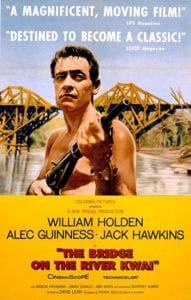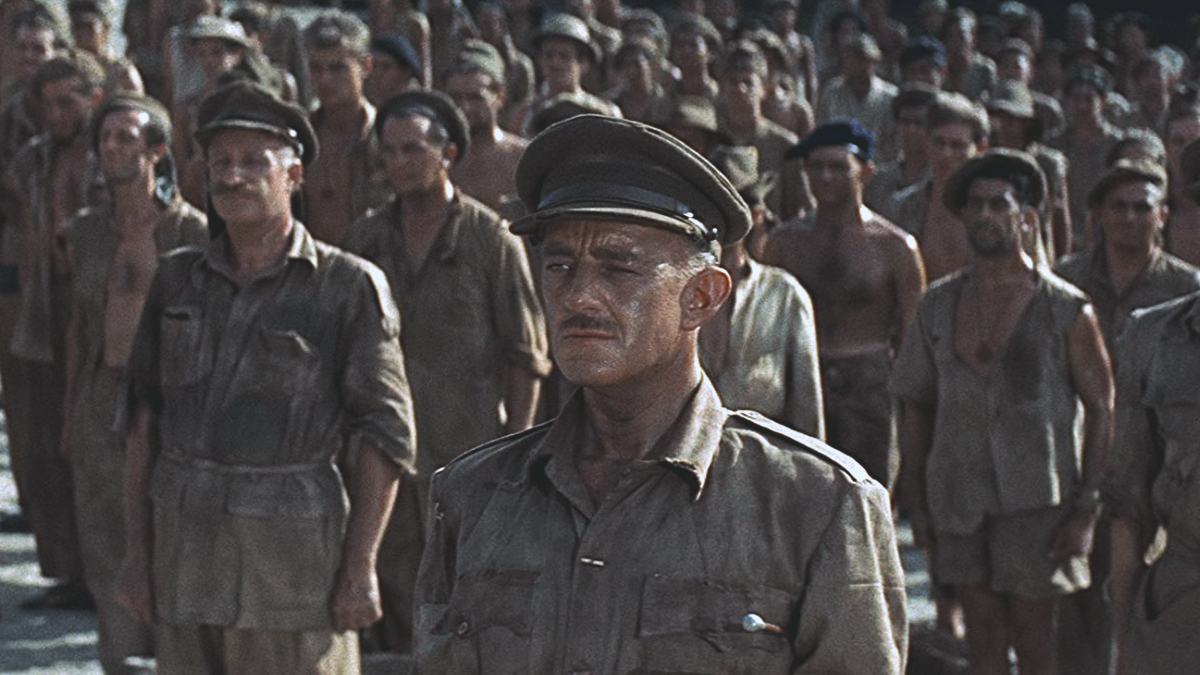The Bridge on the River Kwai (1957)
Film and Plot Synopsis
In the middle of World War II, a group of British POWs are brought to a Japanese internment camp in order to build a bridge that will connect the railways between Bangkok and Rangoon. The commanding officer of the POWS, Colonel Nicholson, begins a battle of wills with the commander of the prison camp, Colonel Saito. Eventually, Nicholson wins the battle but loses himself as he becomes obsessed with completing the Japanese bridge in contradiction to his military training. At the same time, a group of commandos is sent to the Burmese jungle with one mission, the destruction of the bridge on the River Kwai, no matter what.
‘The Bridge on the River Kwai’ Movie Summary
 During World War II, a group of British prisoners of war (POW) are transported by train and foot to a remote prison camp in Burma. The POWs are commanded by the senior British officer, Lieutenant Colonel Nicholson (Alec Guinness), who believes in keeping discipline in the ranks as well as following the rules of law during war. His opposite number in the Japanese army is Colonel Saito (Sessue Hayakawa) who is the ruthless commandant of the prison camp responsible for the deaths of many prisoners.
During World War II, a group of British prisoners of war (POW) are transported by train and foot to a remote prison camp in Burma. The POWs are commanded by the senior British officer, Lieutenant Colonel Nicholson (Alec Guinness), who believes in keeping discipline in the ranks as well as following the rules of law during war. His opposite number in the Japanese army is Colonel Saito (Sessue Hayakawa) who is the ruthless commandant of the prison camp responsible for the deaths of many prisoners.
Saito informs the British soldiers that they are expected to work doing manual labor building a bridge regardless of rank. Nicholson informs Saito that the Geneva Convention exempts officers from manual labor. Saito slaps Nicholson in front of his men and threatens to kill any officers who refuse his order. Only the timely intervention of Major Clipton (James Donald), the camp’s POW medical officer, prevents the execution of the British officers when reminds Saito that there are too many witnesses for him to get away with murder. In the alternative, Saito has the British officers placed in a punishment hut and Nicholson placed in an iron box with little food or water.
While Nicholson is imprisoned, his men follow his orders to not attempt any form of escape. Nicholson and his troops were ordered by headquarters to surrender in their last battle and Nicholson believes that any attempt to escape could be seen as a defiance of their orders from command. However, in Nicholson absence, United States Navy Lieutenant Commander Shears (William Holden) engineers an escape from the camp with two other men who not under Nicholson’s command.
The other two men are shot and killed, but Shears escapes although he is wounded. He floats down river and wanders into a Siamese village, where he is nursed back to health. Once healthy, the Siamese villagers provide him with a canoe and Shears floats down the river until he eventually lands at the British colony of Ceylon.
Back at the camp, the British prisoners work as little as possible without the leadership of their officers. Additionally, they sabotage what they can during their work. Saito falls behind in his deadline to complete the bridge and the railway that will connect Bangkok and Rangoon. If Saito fails to meet the deadline, Japanese custom would obligate him to commit ritual suicide. Although he does not want to give into Nicholson’s strict adherence to the Geneva Convention, Saito eventually uses the anniversary of Japan’s 1905 victory in the Russo-Japanese War as an excuse to save face and grant a general amnesty to Nicholson and his officers. He also gives in and orders that the officers shall not perform manual labor.
Once released, Nicholson is shocked at his men’s work on the bridge as well as their overall lack of discipline and moral. Nicholson orders that his troops cease their sabotage and actually work with the Japanese to build the bridge in good faith. Some of his men protest his orders but Nicholson believes that by giving his men a focused task will restore discipline and moral in the outfit.
He orders Captain Reeves (Peter Williams) and Major Hughes (John Boxer), two soldiers with bridge building experience, to evaluate the Japanese plans and formulate designs to insure that they can complete the bridge by Saito’s deadline. The two men conclude that the Japanese have chosen a poor location for the bridge and recommend relocating the bridge further downstream. Saito, desperate to complete the bridge and avoid suicide, acquiesces to Nicholson’s recommendations and all but defers his troops to the British officer’s command.
Meanwhile, Shears is enjoying his recovery in a hospital in Ceylon. He begins a mild romance with his nurse (Ann Sears). Shears is approached by British Major Warden (Jack Hawkins) who asks him to participate in a debriefing about Saito’s camp as well as the bridge construction. During the debriefing, Warden invites Shears to join a British Special Operations mission to destroy the bridge. Shears refuses and confesses that he is not in fact an actual U.S. officer.
Shears admits that he impersonated an officer in order to receive better treatment from the Japanese. Warden responds to the American’s confession by stating that he is aware of Shears’ deception and that the American Navy had already transferred him to the British unit to avoid any embarrassment. Shears volunteers for the operation after he realizes that he actually has no choice in the matter.
Back at the camp, Nicholson continues to drive his men hard to complete the bridge by Saito’s deadline. To accomplish that goal, Nicholson orders his men to participate in the manual labor, the issue that he was willing to die for when he first entered the camp. He also “requests” that their Japanese counterparts work on completing the railroad to the bridge. A defeated Saito replies that he has already given the order. Nicholson sees the bridge as an example of the ingenuity, hard work, and professionalism of the British Army that will last long after the war. Nicholson has a sign created that commemorates the bridge’s construction by his troops.
Meanwhile, Warden and Shears parachute into the jungle with two other commandos. One is killed on the landing, but the other, Canadian Lieutenant Joyce (Geoffrey Horne), wonders if he has what it takes to kill when called upon. They are joined by some Siamese women from the village that helped Shears that assist them in traveling through the jungle. Along the way, they encounter a group of Japanese soldiers and Joyce hesitates in killing a man, which results in Warden being wounded.
Warden attempts to continue with the mission but eventually he needs to be carried on a litter. The team ultimately reaches the bridge despite the delay. Shears and Joyce plant explosives on the bridge towers below the water line under the cover of darkness. The team plans to detonate the explosives when the first train attempts to cross the next morning. Joyce sets up on the far side of the river and awaits the train.
The next morning, Warden and Shears realize that the river level has dropped during the night and their charges are now visible. To make matters worse, the wire to the detonator is hung up on a tree stump in the middle of the river and is visible. Nicholson’s troops cross the bridge as they begin their trek to their next prison assignment. Nicholson stays behind to travel with his wounded men on the train. He inspects the bridge one last time before the train arrives and notices the wire on the tree trunk in the river. He and Saito climb down from the bridge and begin to investigate.
As Nicholson begins tracking the wire to Joyce’s hiding spot, the Canadian jumps out and kills Saito. Nicholson yells for help from the Japanese soldiers who shoot and kill Joyce. Shears swims across the river and tries to get to the detonator to blow up the bridge. He is shot before he can get there and dies in front of Nicholson who recognizes the American. After seeing Shears killed in front of him, Nicholson suddenly realizes what he has done and turns for the detonator.
Warden launches mortars from the jungle to kill the approaching Japanese soldiers. One of the mortars mortally wounds Nicholson, who is able to recover himself enough to get up and collapse on the plunger of the detonator. The bridge blows up just as the approaching train begins to cross. His mission complete, Warden begins to head back to the Siamese village with the women. Clipton, who was watching from the hillside, shakes his head and states that the entire thing is madness.
Additional Film Information
- Add the film to your collection today
- Listen to Movie House Memory film review
- Peruse IMDb’s article on The Bridge on the River Kwai
- Learn more The Bridge on the River Kwai information at Wikipedia
- Get The Bridge on the River Kwai numbers at Box Office Mojo
- Find out what people think about The Bridge on the River Kwai at Metacritic
- Read The Bridge on the River Kwai reviews from the folks at Rotten Tomatoes
Rate the Film!
Our Rating
Our Rating
Columbia Pictures released The Bridge on the River Kwai on December 14, 1957. David Lean directed the film starring William Holden, Alec Guinness, and Jack Hawkins.
